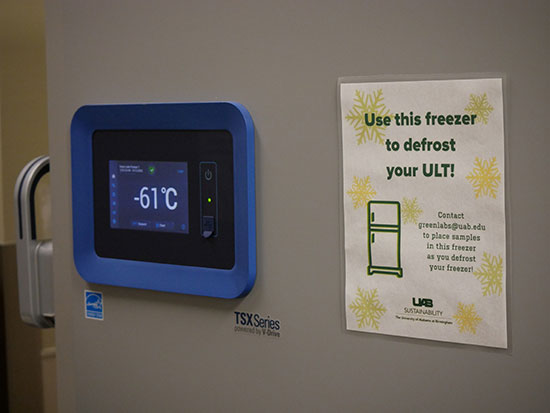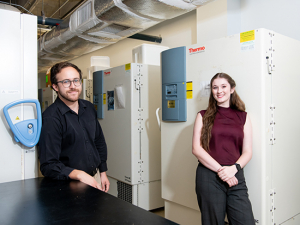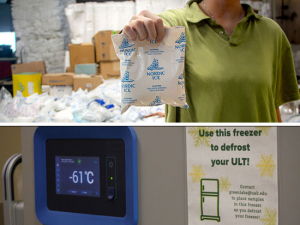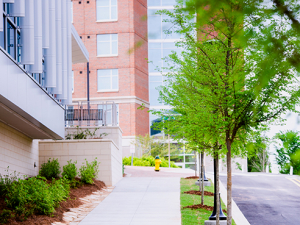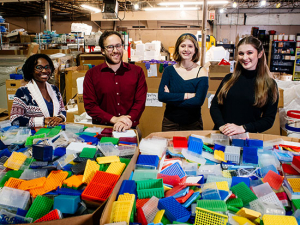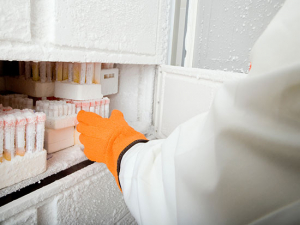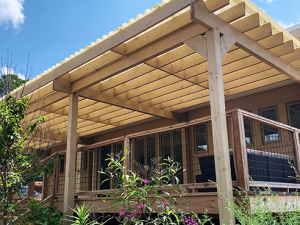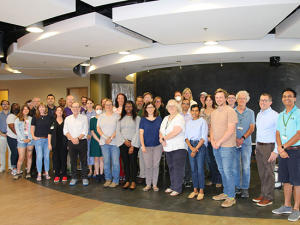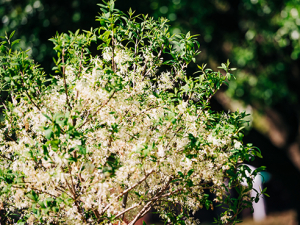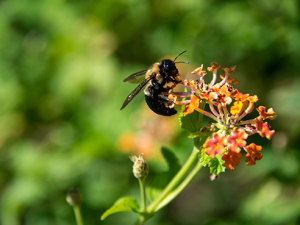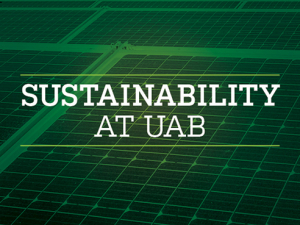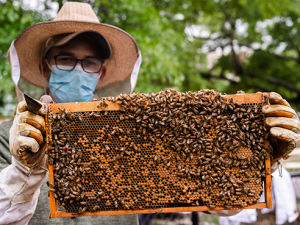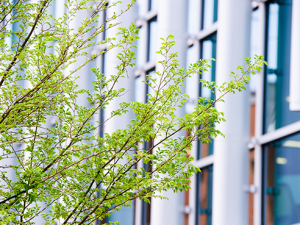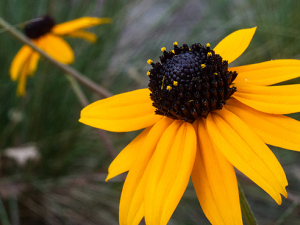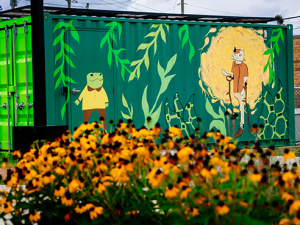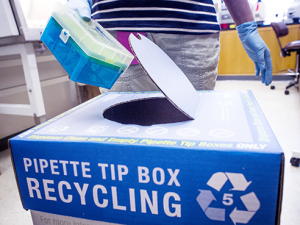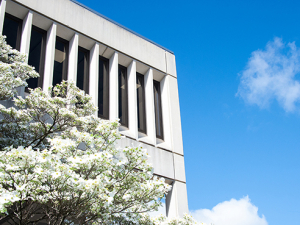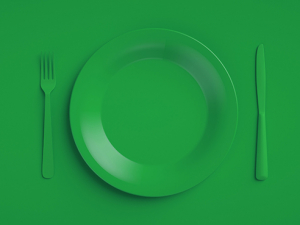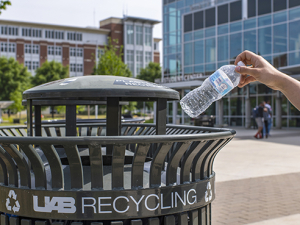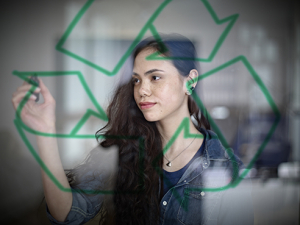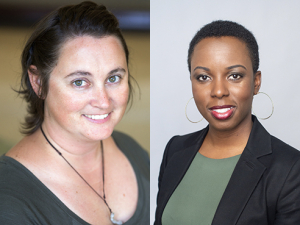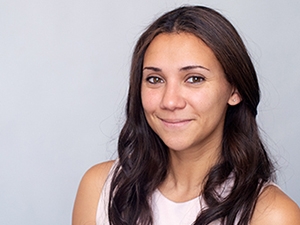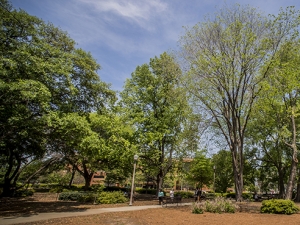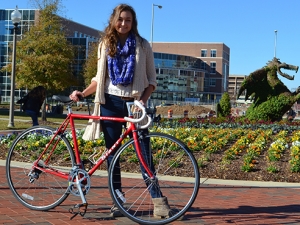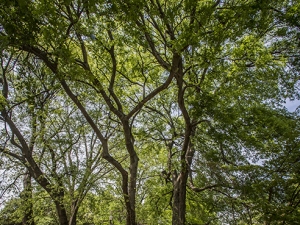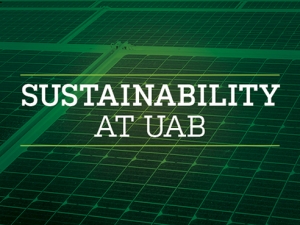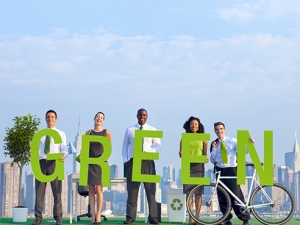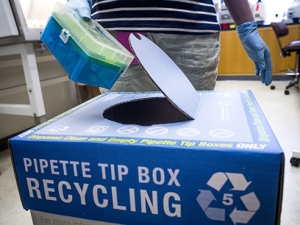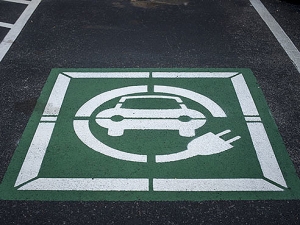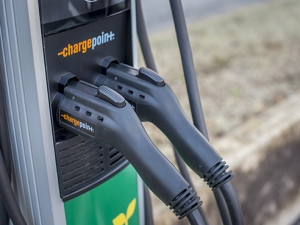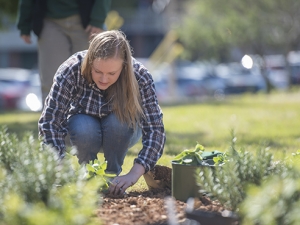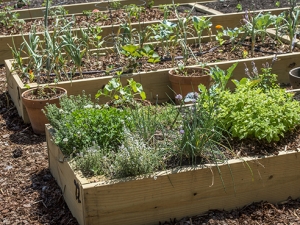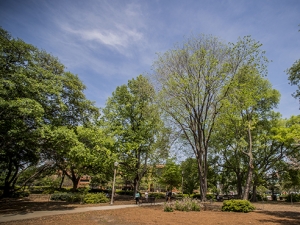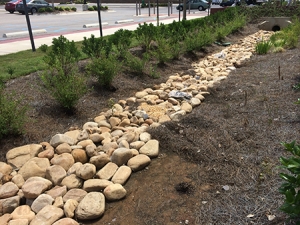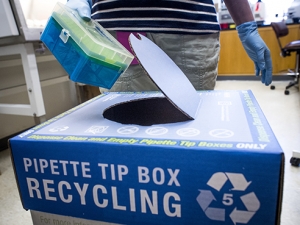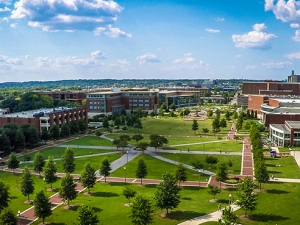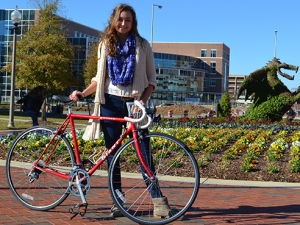UAB’s Green Labs program, which launched with a dozen or so participants in 2016, now counts some 150 labs on its rolls, says Nick Ciancio, sustainability program coordinator for UAB Sustainability. That makes UAB one of the world’s sustainability leaders in academic science, Ciancio says.
But what motivates researchers to take part? And which changes seemed to make the biggest difference? We asked principal investigators and Green Labs representatives (each lab must have one designated) to share their thoughts.
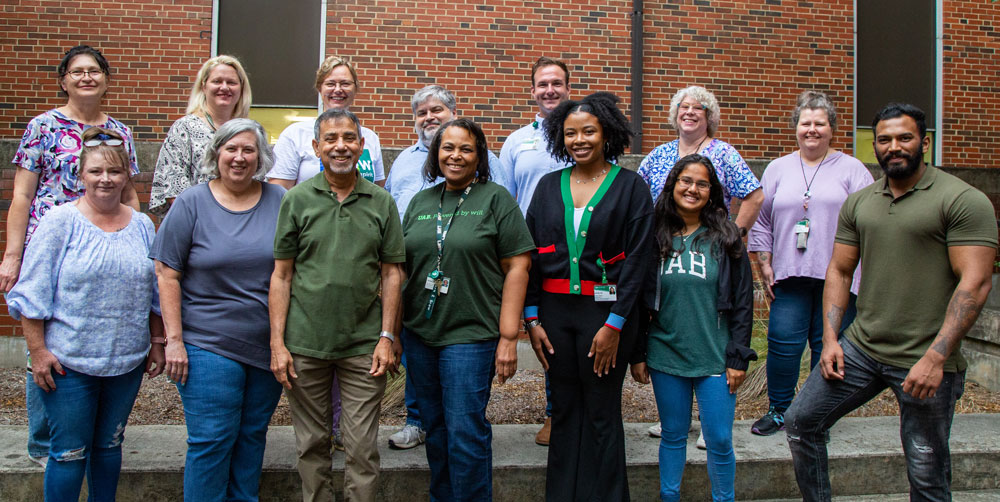 The Van Der Pol lab. Barbara Van Der Pol, Ph.D., is second from right on the top row; Tatyana Gavrikova is third from left on the top row.
The Van Der Pol lab. Barbara Van Der Pol, Ph.D., is second from right on the top row; Tatyana Gavrikova is third from left on the top row.
A big lab makes a big difference
The lab of Barbara Van Der Pol, Ph.D., professor in the Division of Infectious Diseases, is a vast enterprise, stretched across nearly an entire floor of the Zeigler Building. “Predominantly we are an STD [sexually transmitted diseases] diagnostics lab, and we support many clinical research studies of sexually transmitted infections,” Van Der Pol said. “Since 2020, we have also served as a COVID diagnostics lab in support of reaching underserved populations in Alabama.”
The Van Der Pol lab is also a national model — in 2021, the lab was selected as one of 12 individual lab award winners in the annual International Laboratory Freezer Challenge, which included a writeup in the journal Nature. The lab was not eligible to win two years in a row; instead, it took home a Winning Streak award in 2022 — and a brand-new ultra-low temperature, or ULT, freezer from Fisher. The Van Der Pol lab’s efforts in 2022 saved 62,013 kilowatt-hours of power in one year, contributing to the 701,402 kilowatt-hours saved by all UAB participants, Ciancio notes. Those electricity savings from UAB were enough to power nearly 97 homes, he says. (Worldwide, the 2022 Freezer Challenge saved 9.5 million kilowatt-hours.)
“It makes sense for all of us to be green, and the support is there from the university, so it is easy.”
— Barbara Van Der Pol, Ph.D.
Leading-edge diagnostics labs today operate large, semi-automatic machines that, once loaded with patient samples, can test and upload results with little additional intervention. But receiving, preparing, tracking and storing samples — sometimes for years while a study is ongoing — is a logistics challenge. The Van Der Pol lab has more than 35 cooling units in more than a half-dozen individual rooms — ULT freezers capable of reaching –80 degrees Celsius; –20 degree Celsius freezers; and 4 degree Celsius units. Every computer in the lab is equipped with a handheld scanner, of the type you might see at a grocery store self-checkout, to track the location of individual sample vials, explains Tatyana Gavrikova, who is a Researcher V and has been the lab’s Green Labs representative since it joined the program in 2018. “She is entirely responsible for our success,” Van Der Pol said.
“As soon as Green Labs became available, we joined,” Gavrikova said. “It makes sense for all of us to be green,” Van Der Pol added, “and the support is there from the university, so it is easy.”
“Nick showed us studies demonstrating that increasing the temperature to –70 does not have any effect on the RNA or DNA samples that we are working with in our lab.”
— Tatyana Gavrikova
One initial motivator was the specialized recycling provided by Green Labs, with student interns collecting materials from individual labs once a week or on request. “We were receiving 20 or 30 large boxes every week” filled with samples for testing, Gavrikova said. “There were so many that the cleaning staff could not keep up.” (In its new, consolidated space in Zeigler, the Van Der Pol lab has set up a shared room with the labs of fellow Infectious Diseases faculty William Geisler, M.D., and Christina Muzny, M.D., to collect recyclable materials.)
But the bulk of the energy savings noted in the Freezer Challenge, as the name implies, came from decisions around the lab’s freezers, Gavrikova says. The lab replaced its original chest freezers with upright, more efficient models. Intentional work on the lab’s part allowed them to send some samples back to their sources, or obtain permission to dispose of them after a certain period of time. “Now, Dr. Van Der Pol writes that into the contracts: ‘Samples will be sent back to the company,’” Gavrikova said. “This allows us to reduce the number of freezers needed.”
The Van Der Pol lab also changed the temperature settings on many of its ULT freezers from –80 to –70 degrees Celsius. “Nick [Ciancio] showed us studies demonstrating that increasing the temperature to –70 does not have any effect on the RNA or DNA samples that we are working with in our lab,” Gavrikova said. Making that change was not a unilateral decision, she noted: “We worked with the IRB because the storage condition of the samples has to be verified.”
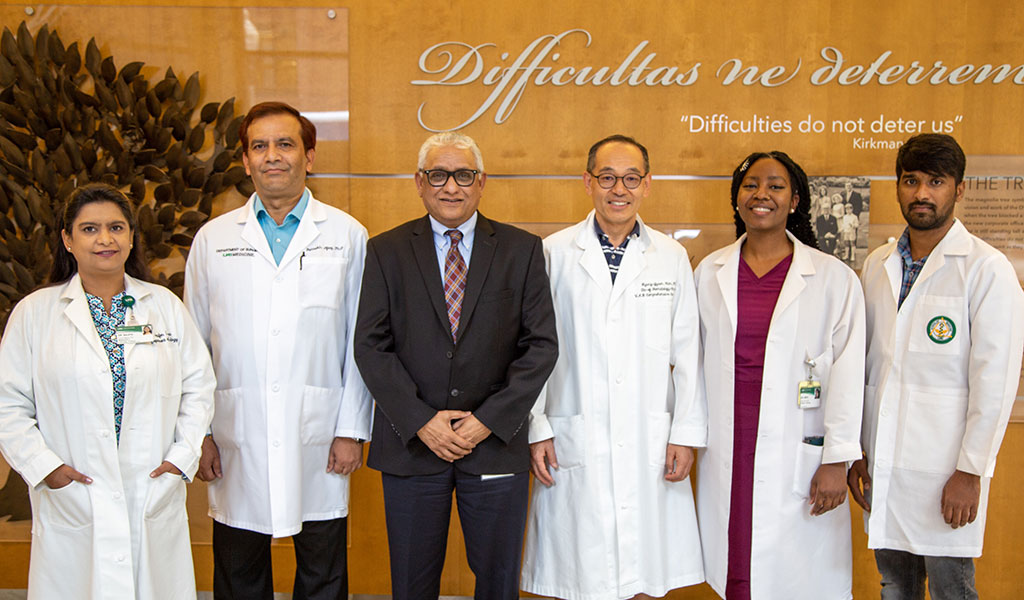 The Manne lab. Upender Manne, Ph.D., is at center; Hyung-Gyoon Kim, Ph.D., is third from right.
The Manne lab. Upender Manne, Ph.D., is at center; Hyung-Gyoon Kim, Ph.D., is third from right.
Maximal impact, minimal effort
The Manne lab's participation in the Green Labs program did “not cost extra money or need a heavy physical workload,” said lab manager Hyung-Gyoon Kim, Ph.D.
In the 2022 Freezer Challenge, the lab of Upender Manne, Ph.D., professor in the Department of Pathology, won the Top Academic Lab Award in the Small Lab category for its efforts in energy sustainability. Lab manager Hyung-Gyoon Kim, Ph.D., served as the Manne lab’s Green Labs representative, and said the lab was excited to win the award with returns on the “minimal efforts” they implemented based on Ciancio’s recommendations. These efforts included setting the temperature of the lab’s ULT freezers from –80 degrees Celsius to –70 degrees Celsius, consolidating frozen samples, regular cleaning of the ULT freezers’ condensing coils and unplugging unused instruments. (Unmaintained freezers use up to 25% more energy than those that are regularly cleaned.) The Manne lab saved 30,879 kilowatt-hours of power in one year (84.6 kWh per day), Ciancio says.
Kim saw the Green Labs changes in action in the adjacent labs on the same floor of the Wallace Tumor Institute, which sparked his interest in participating. “I am from a country where we don’t have many natural resources, and saving energy was very common when I was growing up,” Kim said. And, as he noted in a feature on the 2022 Freezer Challenge in Lab Manager magazine, the work did “not cost extra money or need a heavy physical workload.”
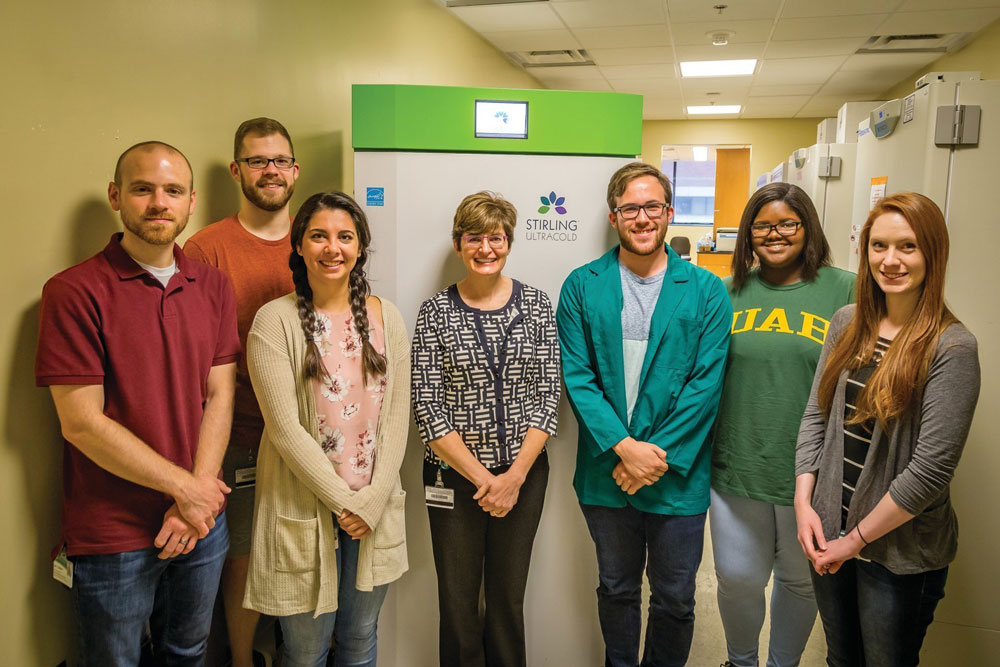 Lyse Norian, Ph.D. (center) has been a member of the Green Labs program since its initial pilot. In this 2018 photo, she and her lab team are shown with Nick Ciancio (green coat) and the freezer they won as part of a Green Labs competition.
Lyse Norian, Ph.D. (center) has been a member of the Green Labs program since its initial pilot. In this 2018 photo, she and her lab team are shown with Nick Ciancio (green coat) and the freezer they won as part of a Green Labs competition.
Bringing personal commitments to the lab
Lyse Norian, Ph.D., an associate professor in the Department of Nutrition Sciences, studies the effects of diet and obesity on immune responses to cancer. When she met Ciancio at a campus event and heard about Green Labs, “I knew I had to participate” as part of the initial pilot program, she said. “I have recycled at home for decades; but I didn’t know how to bring my personal commitments to energy efficiency, landfill waste reduction and sustainability into my research lab. The Green Labs program made this easy for me by providing guidance every step of the way.”
“It’s up to us to determine what will and won’t work for our lab. Nick and his team have always done a great job of providing recommendations that are reasonable, then helping us to implement them.”
— Lyse Norian, Ph.D.
Norian urges fellow lab PIs to give Green Labs a try. “The process is so simple: The Green Labs team surveys lab members about our current practices in a range of areas, then returns to discuss our results and provide us with concrete steps we can take to start improving our sustainability practices,” she said. “It’s up to us to determine what will and won’t work for our lab. Nick and his team have always done a great job of providing recommendations that are reasonable, then helping us to implement them.”
The Green Labs suggestions have influenced her decisions at home as well, Norian says. “I am much more aware of servicing my HVAC system, shutting off computers when not in use and cleaning the vents on my refrigerator, for example,” she said.
“This is such a wonderful program, and I am really proud to be a part of it. Being a Green Labs member means that I am helping UAB as a whole to decrease our impact on the environment and achieve financial savings through reduced energy costs. It’s a win-win situation for everyone involved.”
Related story
What’s new with the planet’s greenest university research enterprise?
UAB’s Green Labs program has grown 700% in six years and now has more than 150 participating labs. New this year: sterilizer streamlining, freezer loans, Styrofoam baling and a vast cache of glass.
